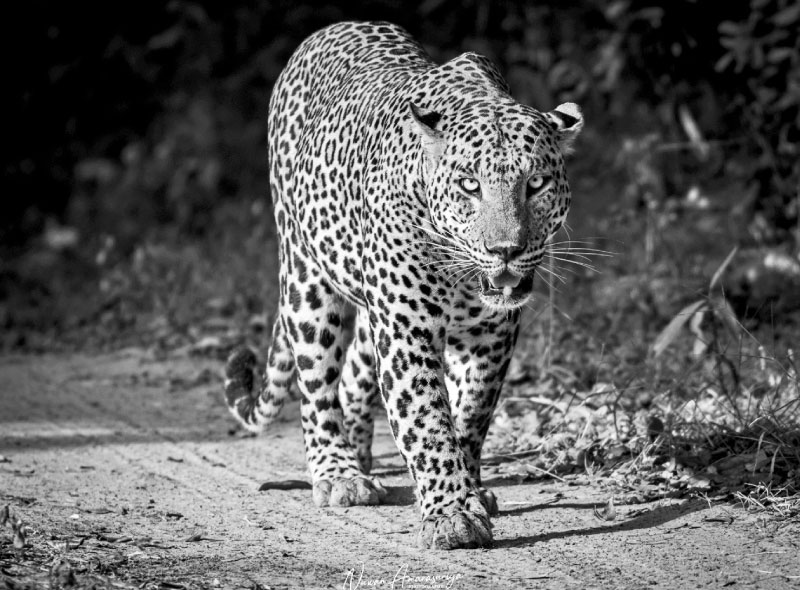Monday Apr 21, 2025
Monday Apr 21, 2025
Tuesday, 1 August 2023 00:00 - - {{hitsCtrl.values.hits}}

Photo credit - Gautham MK
By Rukshan Jayewardene
|
Photo credit - Gautham MK
|
Today being Sri Lanka Leopard Day it is fitting to look at an aspect of leopard behaviour that is often witnessed but not thought of in any great depth except for an emotional response at the time of the sighting. The leopard being an obligate carnivore has to hunt and kill other animals for sustenance. They don’t have a choice of being an omnivorous carnivore as bears do. However, they kill prey animals without malice and out of necessity only.
Of all aspects of leopard behaviour, hunting or predation defines a leopard. More successful than lions, tigers, and perhaps even jaguars, all larger and more powerful cats, the leopard thrives in a wider variety of habitats than any of these larger cats. If one is to use a boxing metaphor the leopard is a welterweight cat while the lion and tiger are heavyweights, the jaguar a light heavy and the other medium cats being light and fly weights. The only other comparable cat is the North American Puma, which has the greatest north-south range spanning the Americas.
The leopard is unique in its combination of disruptive camouflage that blends with almost any background as well as arboreal abilities that match those of smaller arboreal hunters like clouded leopards, Margays, and Ocelots to name a few, while still remaining, primarily a terrestrial hunter. Therefore the leopard’s arboreal abilities can be viewed as an adaptation that allows it to outcompete larger, terrestrial carnivores (not just other cats) and utilise the three-dimensional world of trees to protect itself and its kills.
The leopard is also the quintessential ambush hunter. Its disruptive camouflage allows it to crawl up to prey over substantial distances unseen. The camouflage also allows a leopard to lie in ambush, motionlessly blending with vegetation light and shade patches, grass, leaf litter, earth, rocks, tree trunks, just about anything natural in the environment. The organic pattern of black rosettes on a lighter tawny background, acts to break up the outline of the leopard blending its form and pattern seamlessly with its background.
Once a leopard has got to within striking distance of its prey (or the prey has unknowingly got to that distance from the leopard), the leopard springs into action with blinding speed. The ground between prey and predator is covered by a series of low bounds or jumps. In these enormous jumps the leopard stays close to the ground, giving the impression of running. There are two ways to describe this form of locomotion. The leopard covers the ground similar to a flat stone skipped on water, always low, swift and with slight unpredictable direction changes with each contact with the ground (bounce), but going in the same general direction. Another way to visualise the burst of speed is to imagine the cat alternately changing from rubber band to rubber ball each time contact is made with the ground. The body of the leopard is stretched into a ‘band’ in mid-flight and gathered into a ‘ball’ on landing. A rapid change from kinetic to potential energy that is repetitive and seamless. The leopard also uses its bodyweight to knock its mammalian prey off its feet, so there is a distinct, controlled collision that is audible (especially if the prey animal is heavier than the leopard). Jumping down from a tree onto the back of a prey animal (especially larger ungulates) is also a technique possibly unique to leopards.
Leopards are versatile, adaptable hunters who punch above their weight successfully. Hunting prowess is learnt by watching and imitating the mother, but to a greater extent by trial and error in the early months after independence from the mother. The urge to stalk and hunt is instinctive. Survival during this period of trial and hardship requires judgement; both in the timing of launching an attack as well as the choice of prey. Intrepid and bold does not mean a formula for success, as in the instances of young leopards attempting to kill buffalo calves or wild pigs in Sri Lanka. In these early attempts at hunting dangerous prey, a mistake can cost a leopard to lose its life in the event of a serious injury sustained during a hunt. Even if the injury does not kill the leopard incapacitation can lead to eventual starvation.
Once the technique for hunting each species is perfected, a leopard is able to repeat the process, making leopards among the most successful predators on land. Most leopards will kill and eat mammals, reptiles, birds, amphibians, crustaceans and fish if the need arises. This hunting ability is the key to the vast distribution of the leopard until historic times across the two biggest continents on Earth, Asia and Africa. This success story is first interrupted only with the advent of early humans and human migrations and expansion out of Africa into Asia Minor.
(The writer is a past President of the Wildlife and Nature Protection Society.)

Photo credit - Dushyantha Silva

Photo credit - Nuwan Amarasuriya

Yala hunt